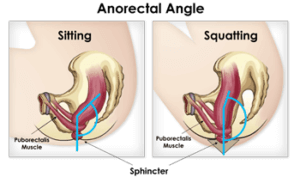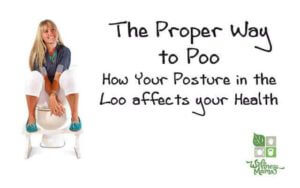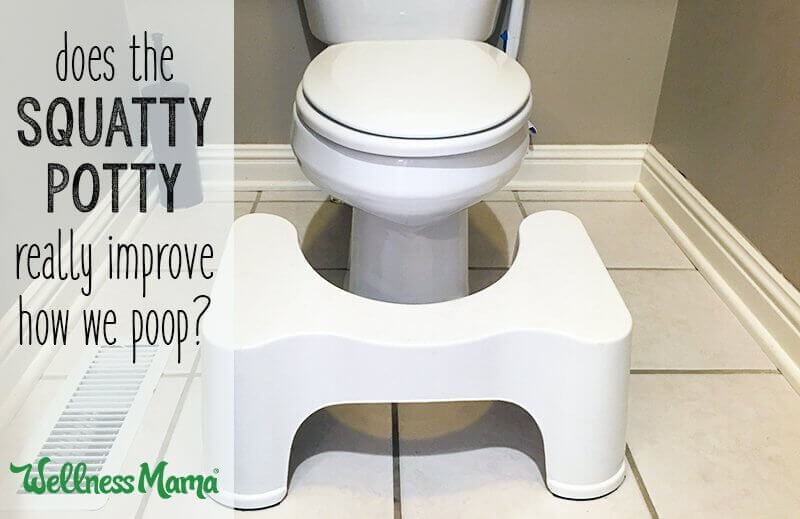I’m constantly researching tools, resources, and health devices to make our lives easier, healthier, and more enjoyable. One of those resources that I’ve used for years is the Squatty Potty.
I first started talking about the Squatty Potty long before they went on Shark Tank and years before they released their viral video about unicorn poop (which is one of the most hilarious videos I’ve ever seen). If you want an even more hilarious read, check out this Squatty Potty review by a new squatting convert!
But unicorns and rainbows aside … does a stool that you stand on while sitting on the toilet really live up to its claims of helping improve the way we poop?
My midwife actually recommended the Squatty Potty during my last pregnancy to help with getting ready to push. It also makes potty training much easier since it is the perfect height for kids to use without falling in.
But there’s some good research showing it may be beneficial for all of us to make going a little easier.
The Idea of Squatting to Poop
The concept of squatting to poo is certainly not a new one. In fact, I was quite surprised the first couple of times I saw toilets designed for this purpose when traveling in other countries. At that time, I just considered it an outdated and primitive toilet, and couldn’t understand why anyone would use one. Not being used to fully squatting, it was certainly comical trying to learn to use it the first time!
Fast forward a few years to my toothpaste and deodorant-making, organic-cooking days and the concept actually didn’t seem so crazy anymore. In fact, I noticed that my young children often do this naturally when the urge to eliminate hits them. I can often tell when my one year old is about to need a diaper change because she is squatting down behind the couch.
So I started looking into the research and it turns out that these cultures who have been squatting for ages may be ahead of the game!
Is the Modern Toilet Causing Problems?
Recently, I’ve seen posts from everyone from Dr. Mercola to Dr. Oz touting the benefits of proper bathroom posture, and even Bill Gates held a contest to redesign the modern toilet. It seems no one loves the traditional toilet, but can position make it better?
Experts claim that the squatting position is more natural and can help avoid colon disease, constipation, hemorrhoids, pelvic floor issues, and similar ailments.
All About the Angle

The basic idea is that the angle makes all the difference when it comes to elimination. When we sit, this creates what is called an anorectal angle, which essentially puts a kink in the elimination process. This creates upward pressure on the rectum and makes it harder to get feces out. The upward pressure also creates the need to strain, even just slightly, to eliminate the stool.
Squatting corrects this angle and removes the kink to let elimination happen more naturally. The squat position is the natural way to achieve easier and more complete elimination. Research has shown that in some people, the kink is completely gone while squatting.
Problems with Sitting on a Regular Toilet
Most of us have been sitting on a “regular” toilet our entire lives and have probably never thought to question this practice. But it turns out that modern toilets that are designed to be more comfortable may actually be contributing to some uncomfortable potty problems, including:
1. Constipation
Let’s face it: most of us aren’t eating the recommended amount of vegetables, much less the optimal amount. And most of us aren’t drinking enough water either. These two things along with improper toilet posture and many other reasons create hard, dry stools that are very hard to push out. It’s called constipation, and we’ve all experienced it. Unfortunately, it’s the norm for altogether too many.
But that’s just the beginning …
2. Hemorrhoids
Several factors contribute to the development of hemorrhoids. Straining during elimination can make them more likely. Increased blood flow of pregnancy creates this uncomfortable problem for many womenz as well. Hemorrhoids are inflamed anal varicose veins that have swollen because of our need to push excessively to get those hard stools to pass. They can be exceptionally painful.
3. Colon Disease
Eliminating completely and often helps maintain good colon health. Many studies point to fecal buildup in the colon as a cause of diseases including colon cancer. And when there is buildup in the colon, our bodies can’t absorb all the nutrients from the food we eat, leaving us without the energy we could enjoy if our colons were healthy.
4. Urinary Difficulty/Infections
Urinary flow is usually stronger and easier when women squat to urinate. The bladder is emptied more completely when squatting rather than sitting or “hovering”. Squatting can help reduce episodes of urinary tract infections in both frequency and intensity.
I personally found during my last pregnancy that using the Squatty Potty to help me squat during urination reduced the need to urinate as often.
5. Pelvic Floor Issues
One of the main causes of pelvic floor issues is straining on the toilet. The “sitting” position causes a great amount of pressure on the anorectal angle of the colon causing the lower part of the colon to drop and protrude into the wall of the vagina. This puts pressure on the pelvic floor and can create unnecessary strain.
Interview with Robert Edwards
To help explain the concept of squatting and how it can be beneficial, I interviewed Robert Edwards, the creator of the Squatty Potty:
Q: How did the concept of the Squatty Potty come about?
A: My mother has suffered from lifelong colon issues and has spent years trying to find a way to alleviate them. A colon hydro-therapist suggested putting her feet up and so she started gathering boxes and stacking phone books in front of the toilet to serve as squatting platforms. The results were immediate, but the method was inconvenient and was always in the way. So, I designed a footstool that fits snugly underneath the toilet when not in use, and is the correct height and slant for use with the westernized toilet.
To create the best possible product, I consulted with doctors, nurses, alignment specialists and natural health experts to identify the perfect height, position and angle ideal for squatting in addition to reading numerous studies on the subject and working with pelvic floor clinics and gastroenterologists nationwide to develop something that they would (and do) recommend to their clients.
We started selling Squatty Potties in fall of 2011 out of our St. George headquarters. We are proud to say that our products are manufactured in the USA.
Q: What are some of the shortcomings of the current way most of us use the restroom?
A: The colon doesn’t fully relax in the sitting position. It isn’t until the colon is in the squatting position that the strain (to go) is eliminated. The kink in your colon maintains continence. Squatting properly aligns the colon and peristalsis is normalized (or quickened).
Q: In short, what is the benefit of using the Squatty Potty compared to just using the restroom “normally?”
A: The Squatty Potty helps create a squatting position while on the toilet which lends itself to better toilet posture, helping users prevent colon disease, constipation, hemorrhoids, and similar ailments.
Q: Can anyone use the Squatty Potty or are there people who won’t be able to use it?
A: Everyone can use the Squatty Potty! Because we have styles that range from 5-9 inches, so most everyone can find a height that works for them. It’s an easy solution for women with pelvic floor issues, seniors with constipation and everyone else in between.
My Experience with The Squatty Potty
The concept of squatting made a lot of sense to me, especially after seeing with myself and other laboring women how relaxation and proper positioning of the sphincter muscles can make a night and day difference in labor (and babies are much bigger!).
I’d noticed in the past how the relaxation techniques I used in labor (relaxing the jaw, natural breathing, etc.) can help elimination be a lot easier, and it made sense that position would have a positive effect (since squatting often makes labor faster and easier as well).
After reading several accounts of people whose elimination was greatly improved by simply changing their position, I attempted to try it their way and just squat on the toilet seat. Sounds easy enough, but I was pregnant at the time and balance was a little difficult. Hilarity ensued.
Does the Squatty Potty Work?
What surprised me with the Squatty Potty was the immediate difference I noticed. The first time I used it, things moved much more quickly (there I go starting with the TMI). Within a few days, this position felt so natural that it was strange to sit in the “normal position” anymore.

Another advantage, as we currently have a baby close to potty training age and the stool is the perfect height for kids to use to climb up to the toilet. Since we started using the Squatty Potty vs. those convertible toilet seats for littles, we’ve had a lot fewer “I-couldn’t-get-there-in-time” accidents. My husband is also very happy that we’ve gotten rid of the free standing kids’ potty, as it had become permanently disgusting after use with multiple kids.
What Size Squatty Potty Is Best?
I was excited to have the chance to try the Squatty Potty, as it is much more convenient that trying to balance on the toilet seat (and more sanitary!). Plus it surely looks a lot better than the empty coconut oil buckets I had tried using.
There are various sizes, but the classic Ecco is 7 inches high and seems to work for most people. The adjustable one can go from 7-9 inches and is a little better for children.
If you haven’t tried it, I’d definitely recommend modifying your restroom posture to see how it will effect your bowel health. I was surprised at the difference and think you will be too!
What do you think? Crazy concept or does it make sense? Have you tried the Squatty Potty? Share below!


Leave a Reply